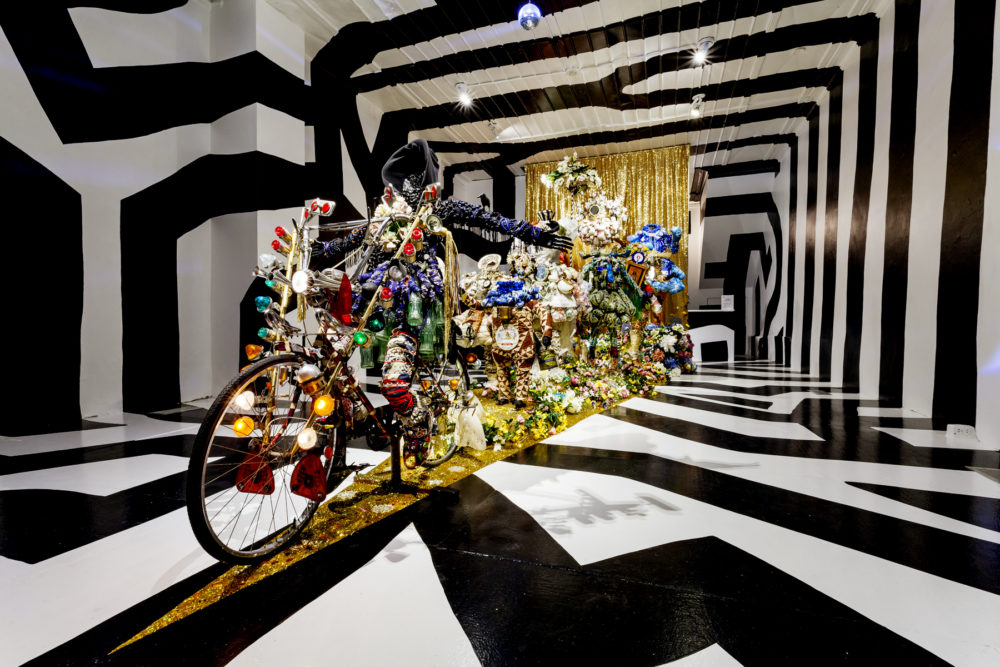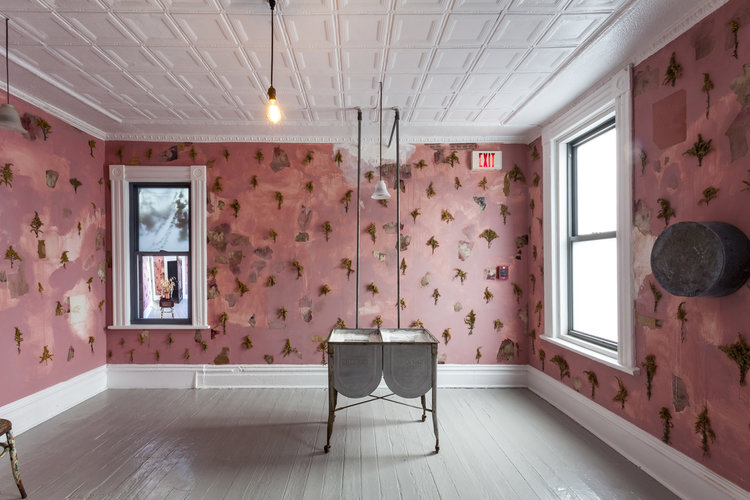
Hard to believe but the Mattress Factory, known as one of the premier venues for installation art, has been in existence for 40 years. During this time, it has attracted and encouraged well known global players, a wide array of artists at various stages of career development and emerging, Pittsburgh based, artists.
Six artists have been chosen to create new work to celebrate this landmark, in addition a selection of work from the Greer Lankton archive.
If you were looking for a perfect example of how someone can latch on to a set of ideas and mine them for a lifetime, look no further than Allan Wexler. In his case, it begins and ends with the concepts of level and gravity, a preoccupation that stems from his background in architecture. In a type of mini-retrospective, the viewer is taken through over 50 years of Wexler’s work. He has spent a good portion of his working life trying to make things level on not level surfaces or making things that were once level off level. Whether it be creating sophisticated stilts Eye Level on a Hill, 2017 so that individuals on opposite sides of a valley could adjust their heights to make sure their eye levels were level, or by using shims under the legs on a table so that it was no longer level and then using more shims on the various plates, utensils and goblets to make them level on the table. Diagrams, models, drawings, photographs of plaster-of-Paris models digitally printed in a tiled format, are all part of his obsessive oeuvre.
Taking the grow room from the greenhouse to the white cube. Two columns and four rows of equally spaced elevated long rectangular black tables filled with a variety of plants including edibles, flowering plants and herbs all under equally spaced grow lights are all part of Meg Webster’s aptly titled installation, Solar Grow Room. The room also features shiny silver metallic reflective material hung from floor to ceiling and rubber floor mats covering the floor. The artist mentions the plight of the bees in her statement perhaps making her own plight to the audience for a greater awareness about our dependency on the essential role of pollination by bees on the plant food cycle and our survival. Saving the bees — a noble aspiration but with an untenable expectation for the magnitude of this installation.
Upon entering the room with the black painted walls in the satellite gallery on 1414 Monterey street, one encounters white plaster-of-Paris heads attached to metal pipes, with assorted plastic animals and other ephemera fastened to the tops of their heads, mounted to the walls like trophies. One quickly realizes these heads belong to the headless figures behind the red curtain. The large second room is painted with wide black and white stripes covering the floor and walls. It features a parade of constructed headless black figures, of all shapes, sizes, genders, and ages walking on a glittering golden path littered with fake flowers and empty liquor bottles and with a shimmering golden curtain as the backdrop. I stumbled into a forbidden private world, a kind of disturbing but oddly familiar place – perhaps a place where I did not belong, as if I were trespassing, but one from which I could not tear myself away. It was an eerie cross pollination of part Wizard of Oz, part Mardi Gras, and part Alice in Wonderland, all brought into focus through the lens of a heartbroken but somehow still hopeful African American female artist. If sometimes we cannot be with our bodies, Vanessa German courageously confronts the heavy weight and burden of the consequences of her heritage: one filled with oppression, bigotry, and stereotypes, and then channels how these collective experiences have shaped how she deals with the racial divide and subsequent legacy that she continues to feel today. As if listening to an encouraging inner voice, or the voice of a mother one hears – “somebody cares about you, someone loves you, and you can go out there and do great things”, signaling a belief and confidence that a brighter future is within reach.

As one walks upstairs to the second floor and enters furniture music, the mood created by artist David Pohl is decidedly different, a place where time stands still. As if trapped inside a Rene Magritte painting in your grandmother’s parlor with
deteriorating 3-d wallpaper, looking out the window watching a bouquet of dried flowers spin on top of an old record player, which is on top of the chair that is inside the room that you are currently inhabiting, all the while listening to the recorded loops of the sounds created by the spinning of these various objects on the turntable, interspersed with mixed piano pieces of ‘furniture music’ composed by Eric Satie. It feels a bit like you have entered the twilight zone and time
travelled through the Dada/Surrealist, Neo Dada, Fluxus movements. Unsettling, yet strangely comforting at the same time.
Travelling up to the third floor, one finds a two room installation by David Ellis. Although known for time lapse recordings of an improvising painting process mixed with musical influences, this work is essentially still images (paintings) created during a four month residency on the east coast of Florida in response to the impacts of Hurricanes Mathew and Irma. Two of the five brightly colored, intricately painted large scale paintings feature bird imagery. The remaining three resemble abstracted versions of hurricanes in progress. The paintings stylistically resemble the work of Lari Pittman. Perplexing as to why Ellis chose to only engage the once privileged sense in this setting.
In the end, it is a difficult task to select only six artists to celebrate 40 years of existence. However, this is an interesting mix of artists for this anniversary exhibition and I was glad to see two Pittsburgh based artists (German and Pohl) were selected as well as artists who were establishing themselves in the 1960’s and 70’s (Wexler and Webster) when installation art was in its infancy. Starting out as pioneers, co-directors Barbara Luderowski and Michael Olijnyk are now part of the art establishment championing an art form that has developed its own language and set of conventions. It is a medium that continues to demand a lot of its audience.
Scott Turri
Scott Turri is our Pittsburgh Editor
Volume 32 no 3 Jan/Feb 2018 pp 32 – 34


I thoroughly enjoyed your review and found it both exciting and fun. It also made me curious to know more, which is in part why a critic reviews an exhibition. Well done.
I have a question for you. Could you tell me why installation art “is a medium that continues to demand a lot of its audience.”?
Well that is a good question Deidre and thank you for you positive words about the review, I am glad I piqued your interest. It is typically not a passive activity, such as looking at paintings for instance. Installation art requires you to become more of a participant in the experience, forcing you to make decisions about how to navigate within a space and how to piece together a multitude of stimuli and information beyond just the sensory experience of vision. If you are not willing to fully commit and engage on a deeper level then you may come away with an empty experience. In other words, there is a greater impetus on the participant to work to gather meaning, perhaps more so then other mediums in my estimation.
I really liked your explanation of installation art requiring the visitor to become more of a participant in the experience ….. beyond just the sensory experience of vision. Installation art vs. paintings makes the visual experience of paintings appear flat by comparison, and of course they obviously are.
Well, thanks Adam. I still think that painting can be very effective as a medium. I mean sometimes I just like looking at something, there can be a kind of stillness or quietness to certain types of painting that I really appreciate. But if you are seeking a more immersive experience then an engaging installation can provide that for an audience.
Does anyone know if a part or all of this exhibition will be shown elsewhere?
I have not heard about it travelling but you might want to ask the Mattress Factory.
Hi David! Mattress Factory, here. All of the works in this exhibition have been created specifically for the Mattress Factory’s unique spaces. The artists may choose to incorporate elements of their installation in future work, but we leave that up to them! David Pohl and Vanessa German’s work will be on view here through April 8, and Meg Webster and Allan Wexler’s work will be on view through July 29.
Thank you very much for this update; I’m looking forward to seeing Meg Webster and Allan Wexler’s work, as I’ll be in Pittsburgh next month. Looking forward to it!
Installation art can profoundly touch you to the core or leave you totally cold; I think there’s no in between. I love it for the interaction and mental images I am left with even after months and years. My dream as an artist was to create a room full of retired briefcases planted in a green cemetery patch, signalling the death of an era where the briefcase was no longer a part of our lives. I wonder if this disuse will also happen to our mobile phones as we get them implanted in our arms. My dream was never fulfilled, as I was not an artist but only a viewer.
Thank you for your answer; I see what you mean and agree that installation art is more involving than a painting, which can appear rather static and only one or two dimensional compared to installation art.